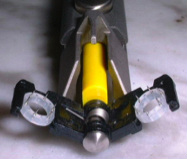
So similar to a plumbing pipe-coupler, plastic surgeons use a coupling device as shown in the picture, to join up the vein using an operating microscope. This has reduced the time taken to connect the veins from 45-50 mins when sutured by hand, down to approximately 8 mins when the coupler is used. In an operation that takes 6 hours , this is a significant time saving and results in less time under an anaesthetic for the patient. And it ensures that a sidewall of the vein is not caught up in a stitch, something one has to look out for in a hand-sewn 'plumbing' of the vein.
For the last 8 years, every Tuesday, when I reconstruct a breast using skin and fat from the tummy (DIEP) or from the inner thigh (TUG), I count the venous coupler as one of my blessings- it makes my surgical life a little bit safer, quicker and more controlled, both for me and for my patients.

 RSS Feed
RSS Feed





